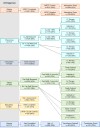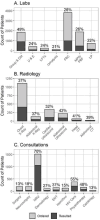Comprehensive assessment of pediatric acute and inpatient care at a tertiary referral hospital in Malawi: opportunities for quality improvement
- PMID: 38719563
- PMCID: PMC11086186
- DOI: 10.1136/bmjpo-2023-002404
Comprehensive assessment of pediatric acute and inpatient care at a tertiary referral hospital in Malawi: opportunities for quality improvement
Abstract
Background: Despite the reduction in global under-5 mortality over the last decade, childhood deaths remain high. To combat this, there has been a shift in focus from disease-specific interventions to use of healthcare data for resource allocation, evaluation of performance and impact, and accountability. This is a descriptive analysis of data derived from a prospective cohort study describing paediatric admissions to a tertiary referral hospital in Malawi for the purpose of process evaluation and quality improvement.
Methods: Using a REDCap database, we collected data for patients admitted acutely to Kamuzu Central Hospital, a tertiary referral centre in the central region. Data were collected from 17 123 paediatric inpatients from 2017 to 2020.
Results: Approximately 6% of patients presented with either two or more danger signs or severely abnormal vital signs. Infants less than 6 months, who had the highest mortality rate, were also the most critically ill on arrival to the hospital. Sepsis was diagnosed in about 20% of children across all age groups. Protocols for the management of high-volume, lower-acuity conditions such as uncomplicated malaria and pneumonia were generally well adhered to, but there was a low rate of completion for labs, radiology studies and subspecialty consultations required to provide care for high acuity or complex conditions. The overall mortality rate was 4%, and 60% of deaths occurred within the first 48 hours of admission.
Conclusion: Our data highlight the need to improve the quality of care provided at this tertiary-level centre by focusing on the initial stabilisation of high-acuity patients and augmenting resources to provide comprehensive care. This may include capacity building through the training of specialists, implementation of clinical processes, provision of specialised equipment and increasing access to and reliability of ancillary services. Data collection, analysis and routine use in policy and decision-making must be a pillar on which improvement is built.
Keywords: Data Collection; Epidemiology; Infant; Mortality.
© Author(s) (or their employer(s)) 2024. Re-use permitted under CC BY-NC. No commercial re-use. See rights and permissions. Published by BMJ.
Conflict of interest statement
Competing interests: None declared.
Figures



References
-
- United Nations . The millenium development goals report 2015. New York: United Nations, 2015.
-
- You D, Hug L, Ejdemyr S, et al. . Global, regional, and national levels and trends in under-5 mortality between 1990 and 2015, with scenario-based projections to 2030: a systematic analysis by the UN inter-agency group for child mortality estimation. Lancet 2015;386:2275–86. 10.1016/S0140-6736(15)00120-8 - DOI - PubMed
-
- United Nations . Transforming our world: the 2030 agenda for sustainable development | Department of Economic and Social Affairs. n.d. Available: https://sdgs.un.org/publications/transforming-our-world-2030-agenda-sust...
-
- World Health Organization . Organisation for economic co-operation and development, international bank for reconstruction and development. delivering quality health services: a global imperative for universal health coverage. Geneva: World Health Organization, 2018:93.
Publication types
MeSH terms
Grants and funding
LinkOut - more resources
Full Text Sources
